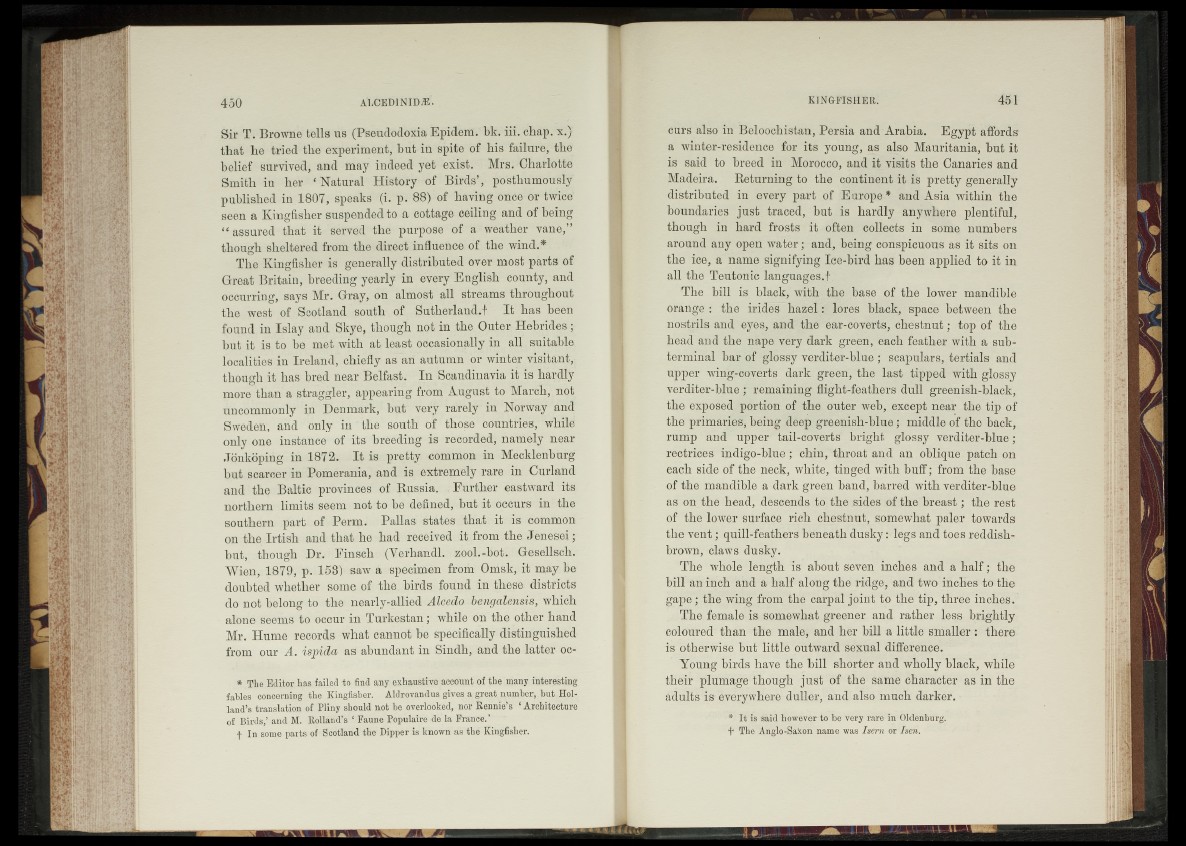
Sir T. Browne tells us (Pseudodoxia Epidera. bk. iii. chap, x.)
that he tried the experiment, hut in spite of his failure, the
belief survived, and may indeed yet exist. Mrs. Charlotte
Smith in her ‘Natural History of Birds’, posthumously
published in 1807, speaks (i. p. 88) of having once or twice
seen a Kingfisher suspended to a cottage ceiling and of being
“ assured that it served the purpose of a weather vane,”
though sheltered from the direct influence of the wind.*
The Kingfisher is generally distributed over most parts of
Great Britain, breeding yearly in every English county, and
occurring, says Mr. Gray, on almost all streams throughout
the west of Scotland south of Sutherland.! It has been
found in Islay and Skye, though not in the Outer Hebrides;
but it is to be met with at least occasionally in all suitable
localities in Ireland, chiefly as an autumn or winter visitant,
though it has bred near Belfast. In Scandinavia it is hardly
more than a straggler, appearing from August to March, not
uncommonly in Denmark, but very rarely in Norway and
Sweden, and only in the south of those countries, while
only one instance of its breeding is recorded, namely near
Jonkoping in 1872. It is pretty common in Mecklenburg
but scarcer in Pomerania, and is extremely rare in Curland
and the Baltic provinces of Russia. Further eastward its
northern limits seem not to be defined, but it occurs in the
southern part of Perm. Pallas states that it is common
on the Irtish and that he had received it from the Jenesei;
but, though Dr. Einsch (Yerhandl. zool.-bot. Gesellsch.
Wien, 1879, p. 158) saw a specimen from Omsk, it may be
doubted whether some of the birds found in these districts
do not belong to the nearly-allied Alcedo bengalensis, which
alone seems to occur in Turkestan; while on the other hand
Mr. Hume records what cannot be specifically distinguished
from our A. ispida as abundant in Sindh, and the latter oc*
The E d ito r h a s fa iled to find any e x h a u stiv e accoun t of th e many in te r e stin g
fa b le s concerning th e Kingfisher. Ald ro v an du s g iv e s a grea t numb er , b u t H o lla
n d ’s tra n sla tio n o f P lin y should n o t b e overlooked, nor R en n ie ’s ‘ A rch ite c tu r e
o f B ird s ,’ an d M. R o llan d ’s ‘ Fau n e P op u la ir e de la F r a n c e .’
f In some pa rts of S co tlan d th e Dippe r is k now n as th e Kingfisher.
curs also in Beloochistan, Persia and Arabia. Egypt affords
a winter-residence for its young, as also Mauritania, but it
is said to breed in Morocco, and it visits the Canaries and
Madeira. Returning to the continent it is pretty generally
distributed in every part of Europe* and Asia within the
boundaries just traced, but is hardly anywhere plentiful,
though in hard frosts it often collects in some numbers
around any open water; and, being conspicuous as it sits on
the ice, a name signifying Ice-bird has been applied to it in
all the Teutonic languages.!
The bill is black, with the base of the lower mandible
orange : the irides hazel: lores black, space between the
nostrils and eyes, and the ear-coverts, chestnut; top of the
head and the nape very dark green, each feather with a subterminal
bar of glossy verditer-blue ; scapulars, tertials and
upper wing-coverts dark green, the last tipped with glossy
verditer-blue ; remaining flight-feathers dull greenish-black,
the exposed portion of the outer web, except near the tip of
the primaries, being deep greenish-blue ; middle of the back,
rump and upper tail-coverts bright glossy verditer-blue;
rectrices indigo-blue ; chin, throat and an oblique patch on
each side of the neck, white, tinged with buff; from the base
of the mandible a dark green band, barred with verditer-blue
as on the head, descends to the sides of the breast; the rest
of the lower surface rich chestnut, somewrhat paler towards
the vent; quill-feathers beneath dusky: legs and toes reddish-
brown, claws dusky.
The whole length is about seven inches and a half; the
bill an inch and a half along the ridge, and two inches to the
gape; the wing from the carpal joint to the tip, three inches.
The female is somewhat greener and rather less brightly
coloured than the male, and her bill a little smaller : there
is otherwise but little outward sexual difference.
Young birds have the bill shorter and wholly black, while
their plumage though just of the same character as in the
adults is everywhere duller, and also much darker.
* I t is sa id h ow ev er to b e v er y rare in Oldenburg.
+ The A ng lo -S a x on nam e was Isern or hen.